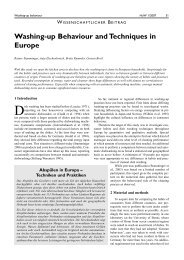Old Washing Machines Wash Less Efficiently and Consume More ...
Old Washing Machines Wash Less Efficiently and Consume More ...
Old Washing Machines Wash Less Efficiently and Consume More ...
You also want an ePaper? Increase the reach of your titles
YUMPU automatically turns print PDFs into web optimized ePapers that Google loves.
126 HuW 3/2005 Comparison Between <strong>Old</strong> <strong>and</strong> New <strong><strong>Wash</strong>ing</strong> Maschines<br />
W ISSENSCHAFTLICHER B EITRAG<br />
Figure 2: Cumulated frequency of washing machine capacitors with their age at<br />
recycling state<br />
cumulated frequency in % �<br />
100<br />
80<br />
60<br />
40<br />
20<br />
0<br />
0<br />
5<br />
10<br />
15<br />
20<br />
age in years �<br />
Source: Own representation. Line is for visualisation only<br />
Figure 3: Specific values of energy usage by washing machines as published by<br />
Stiftung Warentest for the years 1973 through 1991 <strong>and</strong> average specific energy<br />
usage values for the energy label programme as published by CECED for 1996<br />
through 2002<br />
energy in kW h/kg ��<br />
1.2<br />
1.0<br />
0.8<br />
0.6<br />
0.4<br />
0.2<br />
0.0<br />
1970 1975 1980 1985 1990 1995 2000 2005<br />
year of publishing �<br />
Sources: Test 1973-1991; <strong>More</strong>tti 2003, p. 1125<br />
Regression line y = er + ε (x - xr ) characteristics are with:<br />
y = specific energy in kWh/kg<br />
er = specific energy used in reference year<br />
ε = annual improvement in specific energy usage<br />
x = year<br />
xr = reference year<br />
25<br />
30<br />
35<br />
Cotton 90°C programme of<br />
individual machines<br />
Energy label EU average 60°<br />
programme<br />
for 1973-1991: 1996-2002:<br />
x r = 1970 x r = 1995<br />
ε = -0.0214 kW h/(kg a) ε = -0.007 kW h/(kg a)<br />
e r = 0.866 kW h/kg e r = 0.259 kW h/kg<br />
R² = 0.6353 R² = 0.9612<br />
40<br />
change drastically within the last decades,<br />
this figure may be representative for<br />
the life-span distribution independent of<br />
the year of collection of the data used in<br />
this investigation.<br />
3 Published Historical Data<br />
<strong>Consume</strong>r organisations regularly test<br />
household appliances <strong>and</strong> publish data on<br />
water <strong>and</strong> energy usage <strong>and</strong> performance<br />
data. Many consumers appreciate this<br />
information as useful guidance in buying<br />
new appliances. Although testing always<br />
takes place under well-defined conditions,<br />
a comparison of publications by<br />
different institutions <strong>and</strong> from different<br />
times suggests that results are not always<br />
100 % comparable. <strong>More</strong>over, tests usually<br />
refer to specific wash cycles.<br />
Stiftung Warentest is a consumer<br />
organization in Germany that performs<br />
tests. It has tested washing machines on a<br />
regular basis, usually once a year. By<br />
examining their publications from 1973<br />
to 1991 (Test 1973-1991), it is possible to<br />
retrace the history of the water <strong>and</strong> energy<br />
usage values of old washing machines<br />
(Fig. 3). In total 318 published data<br />
records were found. However, it is only<br />
specific values (per kg of textile load)<br />
that are published, <strong>and</strong> comparability<br />
cannot be taken for granted. In the early<br />
nineties, tests started looking at 60 °C<br />
programmes rather than 90 °C programmes,<br />
switching to 40 °C programmes not<br />
long after. At that time, too, the kind of<br />
programme (for moderately or heavily<br />
soiled textiles) used in the tests changed.<br />
In view of these uncertainties, European<br />
averages of water <strong>and</strong> energy usage<br />
determined by the methods set out for the<br />
European Energy Label, which was introduced<br />
in 1996, seem more reliable. The<br />
data collected by CECED, the European<br />
Committee of Domestic Equipment<br />
Manufacturers (<strong>More</strong>tti 2003, p. 1125)<br />
have been averaged over all of Europe<br />
<strong>and</strong> are the best estimate available (note:<br />
differences between the market offer of<br />
washing machines in Germany <strong>and</strong> the<br />
rest of Europe have been levelled since<br />
the introduction of the Energy Label).<br />
These averages were fitted by a linear<br />
curve <strong>and</strong> multiplied by five to calculate<br />
water <strong>and</strong> energy usage per cycle (the<br />
most frequent rated load capacity of was-





